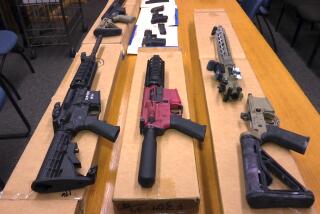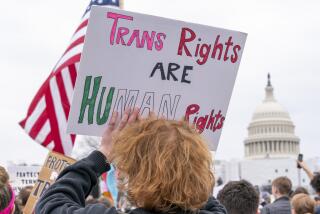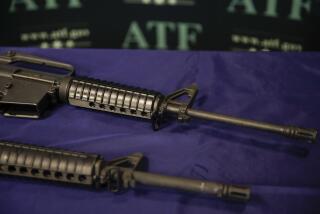Editorial: ‘Ghost guns’ need to be brought out of the shadows

- Share via
California has some of the nation’s most stringent gun restrictions, including a law requiring people who build their own firearms from parts to apply for a serial number so the weapons can be traced. It’s a reasonable law, but like many state gun regulations, it can be hard to enforce.
The fact is, anyone in California can legally order untraceable parts from out of state and, with a little machine work, assemble a gun. It’s pretty easy at that point to ignore the state registration law if you’re inclined to (as well as the requirement that homemade guns include safety devices).
The result: Federal officials say that nearly 1 in 3 guns that police recover at Los Angeles-area crime scenes are just such untraceable built-at-home “ghost guns.” The attacker at Saugus High School in Santa Clarita used a ghost gun to kill two students and himself in November.
Fixing this problem will be up to the federal government.
Without getting too deeply into the technical aspects, the core working mechanism of a gun is called the receiver, which brings together the trigger and other parts of the gun that are key to firing a bullet. In a commercially available firearm, the federal Bureau of Alcohol, Tobacco, Firearms and Explosives requires receivers to be stamped with a serial number that allows investigators to trace the weapon to its initial retail sales point and, beyond that, to the manufacturer. But the gun industry also sells receivers that are not fully drilled out to hold the other parts of a gun, which in the eyes of the ATF means the receiver is not a firearm and thus is not required to have a serial number.
And because it’s not considered a firearm, a receiver can be sold without a background check. Initially the purview of hobbyists and tinkerers, these build-them-yourself ghost guns have become a popular workaround for people whose criminal records, restraining orders or other issues bar them from buying a gun, law enforcement officials say. The lack of an identifying serial number makes them popular with violent criminals and gangs. So naturally, a growing black market has emerged with gun enthusiasts building out the firearms and then selling them without attracting the attention of state or federal regulators.
The ATF didn’t always treat receivers as unregulated. The advocacy group Everytown for Gun Safety, which has petitioned the government to require serial numbers on them, points out that the ATF formerly required serial numbers because it recognized — rightly — that receivers could be easily converted into working firearms. Around 2006, though, the agency began moving away from that position and informed manufacturers that a receiver that did not have a drilled-out recess to accommodate a trigger/hammer system would not be considered a firearm. The agency offered no explanation for the change in approach.
It’s time for the ATF to change its mind again. The Trump administration has been joined at the hip with the National Rifle Assn., which opposes efforts to regulate sale of receivers. But last year, the administration did manage to break away and banned sale and possession of “bump stocks,” which are used to convert semiautomatic firearms into de facto automatic weapons capable of firing scores of bullets in seconds. It was just such a device that allowed the Las Vegas gunman to fire more than 1,000 rounds into the audience at an outdoor concert, killing 58 people, wounding or injuring nearly 900 more. There was, and is, no persuasive argument that such devices belong in civilian hands.
Similarly, there is no good argument for allowing manufacturers to sell do-it-yourself gun kits to evade regulations requiring serial numbers. Serial numbers do not encroach on 2nd Amendment rights, however one frames them, in an unreasonable way. The growing number of ghost guns, and their use in violent crimes, is evidence enough that they pose a risk to public safety and that they make it easier for violent criminals to escape detection.
There is a substantial public interest in ensuring that firearms can be traced to make it harder for bad actors to sell them in an unregulated market, and to make it easier to track down shooters. Fortunately, this can be easily fixed by a federal law or regulation. A regulatory loophole through which so many firearms can pass without detection clearly needs to be closed.
More to Read
A cure for the common opinion
Get thought-provoking perspectives with our weekly newsletter.
You may occasionally receive promotional content from the Los Angeles Times.










